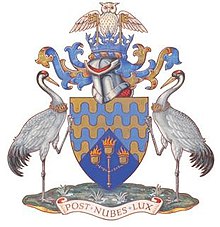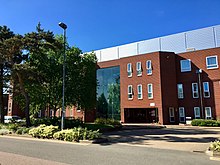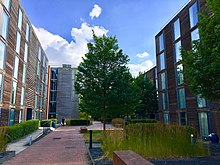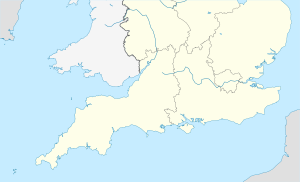Cranfield University
 From Wikipedia - Reading time: 19 min
From Wikipedia - Reading time: 19 min
 | |
Former names |
|
|---|---|
| Motto | Latin: Post Nubes Lux |
Motto in English | After clouds light[1] |
| Type | Public research university |
| Established |
|
| Chancellor | Dame Deirdre Hutton |
| Vice-Chancellor | Dame Karen Holford |
| Students | 5,430 (2022/23)[2] |
| Undergraduates | 180 (2022/23)[2] |
| Postgraduates | 5,255 (2022/23)[2] |
| Location |
|
| Campus | Rural (both) |
| Colours | |
| Affiliations | |
| Website | www |
Cranfield University is a British postgraduate-only public research university specialising in science, engineering, design, technology and management. Cranfield was founded as the College of Aeronautics (CoA) in 1946. Through the 1950s and 1960s, the development of aircraft research led to growth and diversification into other areas such as manufacturing and management, and in 1967, to the founding of the Cranfield School of Management. In 1969, the College of Aeronautics was renamed the Cranfield Institute of Technology, was incorporated by royal charter, gained degree awarding powers, and became a university. In 1993, it adopted its current name.[3]
Cranfield University has two campuses: the main campus is at Cranfield, Bedfordshire, and the second is at the Defence Academy of the United Kingdom at Shrivenham, southwest Oxfordshire.[4] The main campus is unique[5] in the United Kingdom (and Europe) for having its own airport – Cranfield Airport – and its own aircraft, used for teaching and research.
History
[edit]

College of Aeronautics (1946–1969)
[edit]Cranfield University was formed in 1946 as the College of Aeronautics, on the then Royal Air Force base of RAF Cranfield. A major role was played in the development of the college by Roxbee Cox, later Lord Kings Norton, who was appointed to be the first governor of the college in 1945 and then served as vice-chair and (from 1962) chair of the board. He led the drive for the college to diversify, with the Cranfield University School of Management being established in 1967, and petitioned successfully for a royal charter and degree awarding powers. When these were granted in 1969, he became the first chancellor of the Cranfield Institute of Technology, serving until 1997.[6][7]
Cranfield Institute of Technology (1969–1993)
[edit]The Cranfield Institute of Technology was incorporated by royal charter in 1969, giving the institution its own degree-awarding powers and making it a full university in its own right.[8][9][3]
In 1975 the National College of Agricultural Engineering, founded in 1963 at Silsoe, Bedfordshire, was merged with Cranfield and run as Silsoe College.[10]
An academic partnership with the Royal Military College of Science (RMCS) at Shrivenham was formed in 1984. RMCS, whose roots can be traced back to 1772, is now a part of the Defence Academy of the United Kingdom and from 2009 has been known as "Cranfield Defence and Security". RMCS became wholly postgraduate in c.2007 with undergraduate courses moved elsewhere.
Cranfield University (1993–present)
[edit]In 1993 the institution's royal charter was amended changing its name to Cranfield University.[8][9][3] A decade later in 2003, Cranfield became wholly postgraduate and the Shrivenham site admitted its last undergraduates.[11]
In 2007, the university's first international campus was opened by the Prince Edward, Duke of Kent, located in the Torrens Building in Adelaide, alongside the Carnegie Mellon University. It offered short-term postgraduate degrees in defence management and technology, in partnership with local institutions and using some distance learning courses. However South Australia's "defence boom" did not materialise and its failure to attract enough students caused the closure of the campus in 2010.[12][13][14]
In 2009, Silsoe College was closed and its activities were relocated to the main campus at Cranfield.[10]
Location and campus
[edit]
Cranfield campus is approximately 50 miles (80 km) north of central London and adjacent to the village of Cranfield,[15] Bedfordshire. The nearest large towns are Milton Keynes and Bedford, the centres of which are both about 8 miles (13 km) away. Cambridge is about 30 miles (48 km) east.
Shrivenham is about 73 miles (117 km) west of London, adjacent to Shrivenham village, 7 miles (11 km) from the centre of the nearest town, Swindon, and around 23 miles (37 km) from Oxford.
The Cranfield campus sits within the Cambridge – Milton Keynes – Oxford corridor where there are plans to link these cities and stimulate economic growth.[16] There is also a proposal for a rapid transit system between (an expanding) Milton Keynes and the campus, although this is still at an early concept stage.[17]
Technology Park
[edit]There are a number of companies located on the Cranfield University Technology Park ranging from large international companies to small start-ups. Major companies on the park include:
- The Nissan Technical Centre[18] Europe, which designs and develops cars for the European market. The NTC Europe facility occupies 19.7 hectares (49 acres) of the Technology Park, representing an investment of £46m by Nissan.
- Innovation Centre: The Technology Park is also the location for a large number of smaller companies.
Prior to 2016:
- Trafficmaster plc[19] occupied a 10-acre (40,000 m2) site for its European Headquarters. A leading company in telematics, Trafficmaster's advanced technology enables cars and roads to be used more efficiently.
Milton Keynes
[edit]Cranfield University is the academic partner in project with Milton Keynes City Council to establish a new university, code-named MK:U, in nearby Milton Keynes.[20][21] The plan anticipates opening by 2023, with a campus in Central Milton Keynes.[21] In January 2019, the partners announced an international competition to design a new campus near the Central railway station.[22] In May 2019, Santander Bank announced a 'seed funding' grant of £30 million to help with building and initial running costs.[21] On 4 July 2019, the shortlisted proposals for the campus were announced.[23] On 30 July 2019, the evaluation panel announced that Hopkins Architects had produced the winning design.[24]
As of January 2023[update], the project is stalled following a government decision to deny funding.[25]
Coat of arms
[edit]The university's motto, post nubes lux, means 'after clouds light'.[1] It is depicted on the university coat of arms which was introduced when the university was awarded its royal charter.[26]
Organisation and governance
[edit]

Chancellors
[edit]- 1969–1997: Harold Roxbee Cox, Lord Kings Norton
- 1998–2010: Richard Vincent, Lord Vincent of Coleshill
- 2010–2020: Baroness Young of Old Scone
- 2021–present: Deirdre Hutton
Vice-chancellors
[edit]- 1970–1989: Henry Chilver, Lord Chilver
- 1989–2006: Frank Robinson Hartley
- 2006–2012: Sir John (James) O'Reilly[27][28]
- 2013: Clifford Michael Friend – interim vice-chancellor
- 2013–2021: Sir Peter Gregson[29]
- 2021–present: Karen Holford
Schools
[edit]The academic schools are:
- School of Aerospace, Transport and Manufacturing, known as SATM, incorporating the original College of Aeronautics, has a wide range of experimental research facilities for masters and doctoral students and commercial clients
- School of Water, Energy, Environment and Agrifood, known as SWEE and Agrifood (Including Design)
- School of Management, known as SoM
- Cranfield Defence and Security, known as CDS
Academic disciplines
[edit]Disciplines studied in the university include:[30]
- Aeronautical engineering
- Automotive engineering
- Agriculture and agrifood
- Applied Artificial Intelligence
- Automation and control systems
- Business and management
- Chemical engineering
- Civil engineering
- Clean energy
- Computer sciences
- Cyber Security
- Design and innovation
- Ecology and sustainability
- Economics and finance
- Electrical and electronic engineering
- Energy and power
- Engineering
- Environmental sciences
- Forensic Science
- Geography
- Geosciences
- Instruments and instrumentation
- Design and innovation
- Design Thinking
- Engineering photonics
- International relations
- Life sciences
- Manufacturing engineering
- Materials sciences and engineering
- Mathematics and statistics
- Mechanical engineering
- Mechanics
- Meteorology and atmospheric sciences
- Military sciences
- Physics
- Plant and soil science
- Psychology
- Renewable energy
- Robotics
- Safety and Accident Investigation
- Social sciences
- Systems sciences
- Transportation science and technology
- Water sciences
Academic profile
[edit]Reputation and rankings
[edit]| Global rankings | |
|---|---|
| ARWU (2024)[31] | 801–900 |
As an exclusively postgraduate university, Cranfield University is excluded from the Times Higher Education World University Rankings, The Times World Rankings, The Complete University Guide and The Guardian, which focuses on helping prospective undergraduate students to compare universities. Consequently, direct comparison with undergraduate institutions is difficult. Some key facts and figures are:
- Eighty-eight per cent of Cranfield's research was rated world-leading or internationally excellent in the 2021 Research Excellence Framework (REF).[32][better source needed]
- Cranfield School of Management's full-time one-year MBA programme was ranked 9th in the UK, 27th in Europe and 80th in the world in the flagship 2024 Financial Times Rankings.[33][better source needed]
- Cranfield School of Management ranked 8th in the UK and 37th in Europe in the Financial Times European Business School Rankings 2023.[34]
- Cranfield University ranked in the world top 30 for Mechanical, Aeronautical and Manufacturing Engineering in the 2024 QS World University Rankings by Subject. In ‘Business and Management’ Cranfield maintains a top 150 position, and it also keeps a top 200 position in ‘Environmental Sciences’. Cranfield’s ‘Materials Science’ subject area has moved up into the global top 200.[35]
- Cranfield is in the top 15% of universities globally in the QS World University Rankings: Sustainability 2024.[36] The Times Higher Education Impact Rankings 2023 placed Cranfield in the global top 40 for our actions supporting the UN Sustainable Development Goal 17.[37]
- Cranfield has received the Queen's Anniversary Prize six times: in 2005 for Further and Higher Education for the Fellowship in Manufacturing Management (FMM) programme; in 2007 for its role in humanitarian demining;[38][better source needed] in 2011 for contribution to aviation safety through research and training in accident investigation;[39] in 2015 for its work in water and sanitation;[40] in 2017 for its research and education in large-scale soil and environmental data for the sustainable use of natural resources.[41][better source needed] and in 2019 for the work of the National Flying Laboratory Centre;[42]
- Students on Cranfield's Global Security programme were awarded the Imbert Prize in 2006,[43] 2008[44] and 2009[45] for the development of ideas for the advancement of risk and security management in the UK.
Admissions
[edit]Cranfield welcomes around 5,000 postgraduate students from more than 100 countries each year.
Cranfield University's student to academic staff ratio is 5:1, one of the best ratios in all UK universities.[46]
41% of Cranfield University's students are over 30 years of age.[46]
Partnerships
[edit]Cranfield University has links with business, industry and governments. Cranfield University has mutually beneficial relationships with nearly 1,500 organisations around the world including small owner-managed SMEs to large multinational conglomerates; British and international universities, non-government organisations and governments. Some of Cranfield's close partnerships include Airbus, Rolls-Royce Group, Grant Thornton, BAE Systems, Boeing, Lockheed Martin, Ford, BP, British Airways, PWC, Jacobs, Metro Bank, L'Oréal, Royal Dutch Shell, Jaguar Land Rover, Oracle Corporation, PepsiCo, Unilever, to name just a few.[47]
Cranfield University has links with more than 130 universities in the Americas, Asia and Oceania, Europe, Middle East and Africa.[48] The university collaborates with the Singapore University of Social Sciences (SUSS) on SUSS's BEng Aerospace Systems.[49]
The IMRC – Innovative Manufacturing Research Centre at Cranfield University is a project funded by the EPSRC (Engineering and Physical Sciences Research Council) undertaking research that addresses issues identified in the UK government's High Value Manufacturing strategy.[50]
Student life
[edit]
Facilities at the Cranfield University campus include a sports centre, which incorporates a fitness centre and aerobics studio, playing fields, sports pitches and several tennis courts. On campus there are two small shops, one run by the CSA and one by Budgens. There are a limited range of eateries open during mealtimes, two Costa Coffee outlets, and one bar, also run by the CSA, which is open intermittently Monday to Friday.
Students' union
[edit]Cranfield Students Association (CSA) is the students' union and runs the main student bar, cafe and shop on the Cranfield campus. It is based in building 114 close to the centre of the campus.
The CSA is run by a team of elected students and supported by a small team of staff. The aim of the CSA is to support and represent Cranfield University students, promote student welfare and organise social, cultural and sporting activities.
Student accommodation
[edit]At the Cranfield University campus there are a wide range of accommodation options for full-time students, from halls of residence to shared houses, apartments for couples and houses for families.
For part-time students, there are two options available – the 186-room Cranfield Management Development Centre and the 114-room Mitchell Hall, both of which are situated on campus.
Notable alumni
[edit]This article's list of alumni may not follow Wikipedia's verifiability policy. (April 2019) |
Cranfield University has a number of notable academic staff and alumni, including politicians, business people, entrepreneurs, engineers, scientists, authors, and TV personalities.
Cranfield University is in the top 1% of institutions in the world for alumni who hold CEO positions at the world's top companies according to the Centre for World University Rankings, 2017.[46]
-
Antony Jenkins – former group chief executive, Barclays
-
Warren East – former CEO, Rolls-Royce Holdings
-
Winnie Byanyima – executive director of UNAIDS
-
Andy Palmer – former CEO, Aston Martin
-
Sarah Willingham – entrepreneur and former "dragon" on the series Dragons' Den
- Sophie Adenot - Astronaut, one of the candidates selected in the 2022 European Astronaut Corps.
- Nader Al-Dahabi - Former prime minister of Jordan
- Akinwunmi Ambode - Former Governor Lagos State, Nigeria
- Michael Bear (Lord Mayor) - The 683rd Lord Mayor of London
- Karan Bilimoria – Founder and chairman, Cobra Beer Ltd[51]
- Crispin Blunt – Member of Parliament for Reigate
- Andy Bond – Former CEO, Asda
- Clifford Braimah - Managing Director Ghana Water Company Limited
- Winnie Byanyima - Executive director of Oxfam International[52]
- L. J. Clancy – author of Aerodynamics (1975)
- Nigel Doughty - Former co-chairman and co-founder of Doughty Hanson & Co
- Warren East – Former CEO, Rolls-Royce Holdings
- Andy Harrison – Former CEO, Whitbread
- Jack Hathaway - Astronaut, one of the 10 candidates selected in the 2021 NASA Astronaut Group 23.
- John Hull – Professor of Derivatives and Risk Management at the University of Toronto
- Major Charles Ingram - English fraudster and novelist
- Antony Jenkins – former Group Chief Executive, Barclays
- Nick Jenkins – Founder of online greetings card retailer Moonpig, former "dragon" on the BBC Two business series Dragons' Den
- Stathis Kefallonitis – neuroscientist and member of the leadership team at United Airlines
- Brian Norton – solar energy technologist, President, Dublin Institute of Technology
- Siddhartha Lal - chief executive officer and managing director of Eicher Motors, and chairman and managing director of VE Commercial Vehicles
- Martin Lamb – chief executive, IMI plc
- Samer Majali - CEO / President of Royal Jordanian airlines
- Charlie Mayfield – chairman, John Lewis Partnership
- John McFarlane – executive chairman, Barclays[53]
- Lara Morgan – founder, Company Shortcuts
- Ashitey Trebi-Ollennu - robotics engineer at NASA
- Juan Rafael Elvira Quesada - Served as Secretary of the Environment and Natural Resources
- Nigel Quinn, water resources engineer, earth scientist
- Andy Palmer - Former CEO, Aston Martin
- Lyndon Smith - Professor in Computer Simulation and Machine Vision, University of the West of England[54]
- Haslina Taib - CEO Dynamik Technologies, Brunei
- Ted Tuppen – CEO, Enterprise Inns Plc
- James Vowles - team principal at Williams Racing Formula 1 team
- Sarah Willingham – entrepreneur and former "dragon" on the BBC Two business series Dragons' Den
- Balakrishnan Suresh - Air Marshal and Chief of WAC in Indian Air Force
- Satya Widya Yudha - Member of the National Energy Council of the Republic of Indonesia
Gallery
[edit]-
Cranfield University Birdseye view
-
Cranfield University CMRI
-
Cranfield University IMEC
-
Cranfield University Sports Hall
-
C4D Building, the Centre for Creative Competitive Design, opened 2010
-
Army helicopter display team, graduation 2004
-
RAF Red Arrows display team, Shrivenham graduation, July 2003
-
The new Vincent Building's interior, June 2008
-
Lanchester Hall
-
Kent House
-
Cranfield Library
-
Boeing 737 G-DOCB arrives at Cranfield University
-
Cranfield University C4D Centre for Design
-
Cranfield University
-
Cranfield University Library
-
Cranfield's Flying Classroom
-
Digital Aviation Research and Technology Centre
See also
[edit]- Academics of Cranfield University
- Armorial of UK universities
- Cranfield experiments
- Cranfield Institute
- Facility for Airborne Atmospheric Measurements
- List of UK universities
- Royal School of Military Survey
References
[edit]- ^ a b "The Arms of the University". Cranfield University. Retrieved 1 July 2017.
- ^ a b c "Where do HE students study?". Higher Education Statistics Agency. Retrieved 23 September 2024.
- ^ a b c "Cranfield College of Aeronautics history". Cranfield University. n.d. p. 1. Archived from the original on 9 July 2016. Retrieved 28 December 2017.
The institution ... was granted university status in 1969 becoming the Cranfield Institute of Technology and it changed its name to Cranfield University in 1993
- ^ "How to find us - Cranfield University at Shrivenham". Cranfield University. Retrieved 1 July 2017.
- ^ Piesing, Mark. "The university shaping aviation's future". www.bbc.com. Retrieved 26 January 2021.
- ^ "History and heritage". Cranfield University. Retrieved 1 July 2017.
- ^ "Cranfield University". Lord Kings Norton. Cranfield University. Retrieved 1 July 2017.
- ^ a b Swain, Harriet (23 January 2012). "Is Cranfield's postgraduate-only university a model for the future?". The Guardian. Retrieved 28 December 2017.
- ^ a b "Cranfield University". The Independent. 23 July 2014. Retrieved 28 December 2017.
- ^ a b "Silsoe college remembered on new homes estate". Bedford Today. 15 December 2013. Retrieved 1 July 2017.[permanent dead link]
- ^ "Analysis: Military redeploys intellectual might". Times Higher Education. 29 November 2002. Retrieved 26 December 2009.
- ^ Parsons, Alexander (7 July 2017). "Torrens Building". Adelaidia. Retrieved 15 November 2019.
This entry was first published in S.A.'s Greats: The men and women of the North Terrace plaques, edited by John Healey (Historical Society of South Australia Inc., 2001).
- ^ Cohen, David (8 August 2007). "Coalition courses". The Guardian. Retrieved 16 November 2019.
- ^ King, Malcolm (4 February 2015). "Adelaide's "uni city" dream is over". In Daily. Retrieved 16 November 2019.
- ^ "Cranfield Village Newsletter including a history and information on the airfield". Cranfield Parish Council. Archived from the original on 7 June 2007.
- ^ "Sajid Javid exclusive interview: Garden towns and expressway to sprout up in Oxbridge corridor". The Times. Retrieved 23 May 2018.
- ^ "National Infrastructure Commission - Cambridge, Milton Keynes and Oxford Future Planning Options Project Final Report" (PDF). National Infrastructure Commission. Archived from the original (PDF) on 11 April 2019. Retrieved 23 May 2018.
- ^ "Nissan UK". Nissan, UK. Retrieved 10 June 2007.
- ^ "Trafficmaster plc". Trafficmaster plc. Retrieved 10 June 2007.
- ^ "Project Two: MK:U A new University for Milton Keynes". MK2050 Futures Commission. October 2017. Retrieved 6 February 2019.
- ^ a b c "Santander provides £30m boost to plans for innovative new university in Milton Keynes". MKFM. 28 May 2019. Retrieved 28 May 2019.
- ^ Fulcher, Merlin (31 January 2019). "Competition: MK:U, Milton Keynes". Architects' Journal. Retrieved 6 February 2019.
- ^ Fulcher, Merlin (4 July 2019). "Milton Keynes £188m university contest finalists revealed". Architects' Journal. Retrieved 4 July 2019.
- ^ "Milton Keynes university contest winner revealed". Architects Journal. 30 July 2019. Retrieved 30 July 2019.
- ^ Murrer, Sally (19 January 2023). "Milton Keynes' plan to create world-class university in tatters after government refuses multi million pound funding". Milton Keynes Citizen. Retrieved 20 January 2023.
- ^ "Cranfield University History". Cranfield University. Retrieved 22 May 2018.
- ^ "Sir John O'Reilly". Engineering and Physical Sciences Research Council, UK. Archived from the original on 7 June 2007. Retrieved 9 June 2007.
- ^ "Sir John O'Reilly". Cranfield University - Biography. Archived from the original on 18 July 2009. Retrieved 18 March 2009.
- ^ "Professor Sir Peter Gregson FREng". Cranfield University - Chief Executive and Vice-Chancellor. Retrieved 27 February 2014.
- ^ "Cranfield University Academic Disciplines". Cranfield University. Retrieved 22 May 2018.
- ^ "Academic Ranking of World Universities 2024". Shanghai Ranking Consultancy. 15 August 2024.
- ^ "REF 2021: Cranfield research is world-leading with a global impact". Cranfield University. Retrieved 8 May 2024.
- ^ "Rankings". Cranfield University. Retrieved 8 May 2024.
- ^ "Rankings". Cranfield University. Retrieved 8 May 2024.
- ^ "QS World University Rankings by Subject 2024". Top Universities. Retrieved 8 May 2024.
- ^ "QS Sustainability University Rankings 2024". Top Universities. 4 May 2024. Retrieved 8 May 2024.
- ^ "Impact Ranking". Times Higher Education (THE). 11 May 2023. Retrieved 8 May 2024.
- ^ "Queen's Anniversary Prize". Cranfield University.
- ^ staff@webstarsltd.com, WebstarsLtd.com //. "Winners of the Queen's Anniversary Prizes announced". www.royalanniversarytrust.org.uk.
- ^ "Cranfield University-Research Changes Tide". Bedfordshire on Sunday.[dead link]
- ^ "Cranfield University Rankings and Awards". Retrieved 22 May 2018.
- ^ "'Flying classroom' lands University the highest UK honour" (Press release). Cranfield University. 20 February 2020. Retrieved 24 March 2020.
- ^ Sims, Brian (3 August 2006). "Burrill, Cahalane and Finch win Imbert Prizes". Info4Security. Archived from the original on 13 July 2011. Retrieved 26 June 2009.
- ^ "ASC lunch". Professional Security Magazine. 30 June 2008. Archived from the original on 3 October 2011. Retrieved 26 June 2009.
- ^ Sims, Brian (30 June 2009). "Policing with a Brain: the 2009 ASC Annual Luncheon". Info4Security. Archived from the original on 13 July 2011. Retrieved 30 June 2009.
- ^ a b c "Cranfield University Fact and Figures". Retrieved 22 May 2018.
- ^ "Cranfield University International Partnerships (Who we work with)". Cranfield University International Partnerships. Retrieved 22 May 2018.
- ^ "Cranfield University International Partnerships". Retrieved 22 May 2018.
- ^ "Collaborations with Overseas Universities". SUSS. 29 May 2018. Archived from the original on 29 May 2018. Retrieved 29 May 2018.
- ^ Government Opportunities Archived 27 November 2018 at the Wayback Machine retrieved 11 April 2013
- ^ "Karan Bilimoria - Founder of Cobra Beer". London Speaker Bureau. Archived from the original on 3 May 2016. Retrieved 21 May 2018.
- ^ "Hundreds celebrate, as in-person graduation ceremonies return to Cranfield University".
- ^ "John McFarlane OBE, awarded honorary degree from Cranfield". Cranfield School of Management.
- ^ Who's Who in Science and Engineering: 2002-2003. Marquis Who's Who; 6th edition. 2001. p. 906. ISBN 0837957605.
Further reading
[edit]- Barker, Revel (1996). Field of Vision: Cranfield University, the First Fifty Years. Cranfield, Bedforshire, UK: Cranfield University Press. ISBN 1-871315-60-3.
 KSF
KSF























